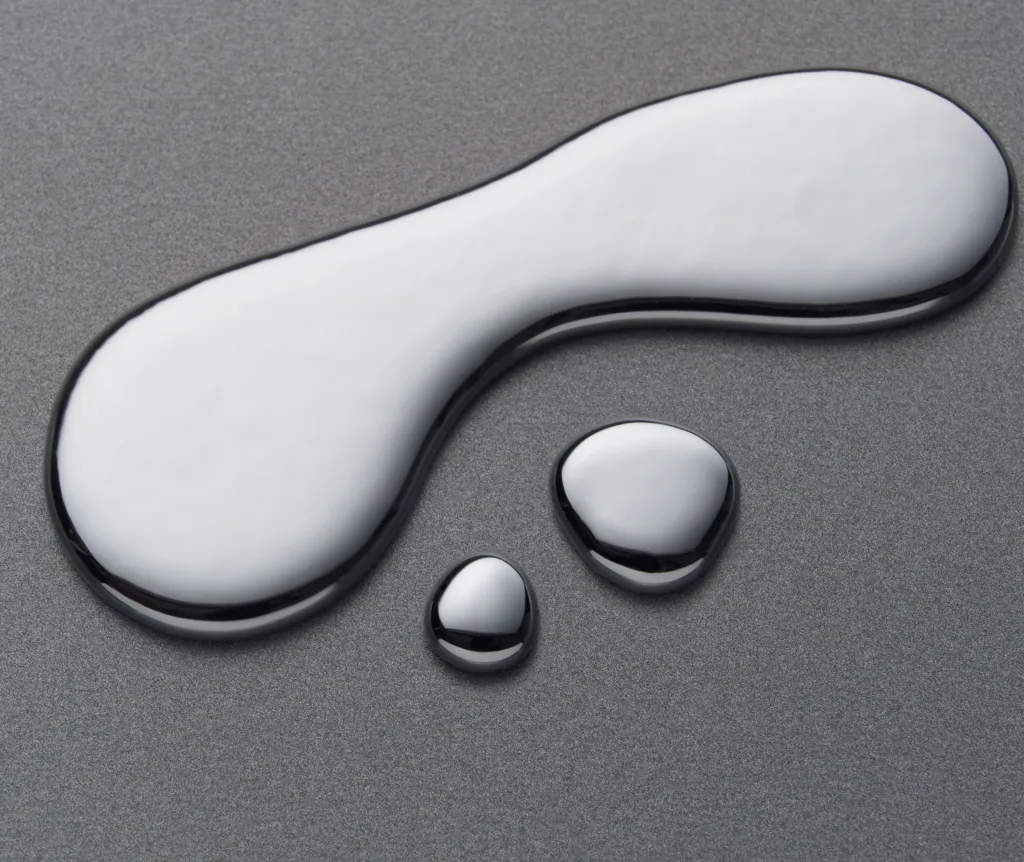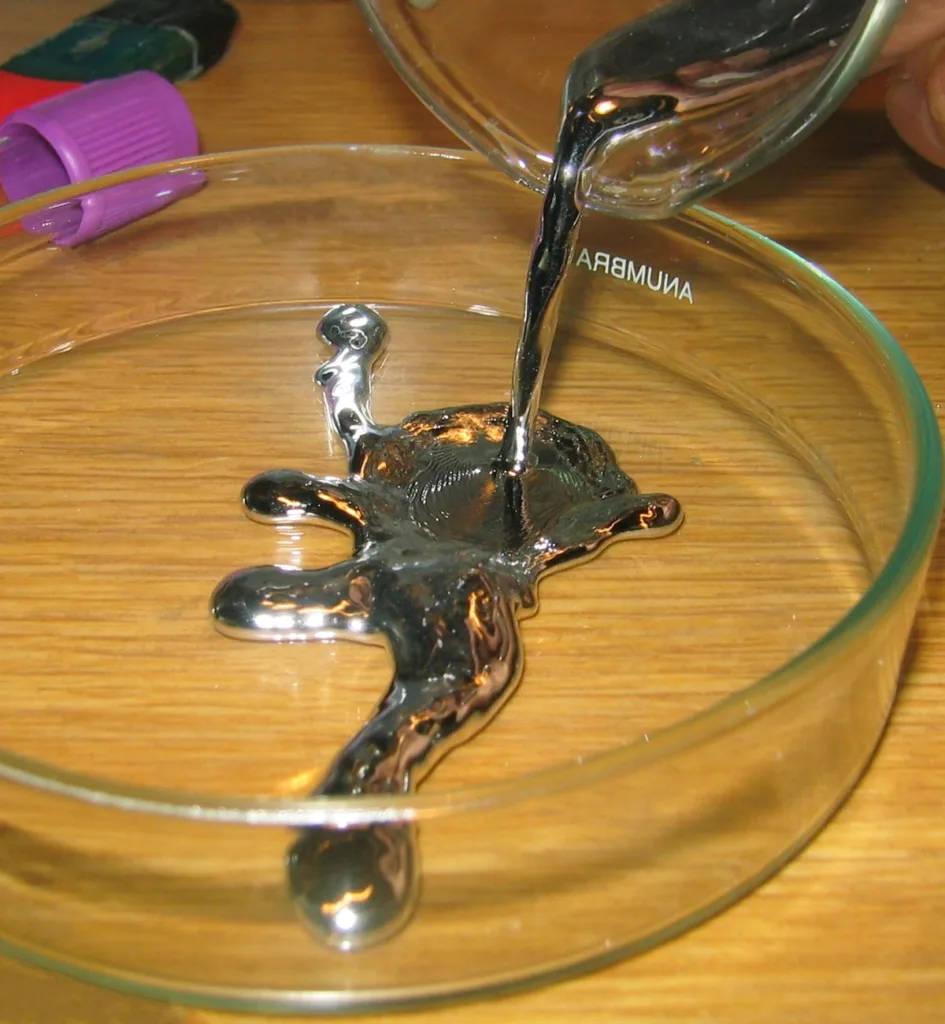Mercury is a highly toxic element that can cause severe health problems when exposed to humans. It is a shiny, silvery liquid metal that can easily vaporize at room temperature. When mercury vaporizes, it becomes an invisible, odorless toxic vapor that can last up to one year in the air.
Breathing in mercury vapor is the most common exposure pathway for humans. When elemental mercury is spilled, it can slowly vaporize and contaminate indoor air. This can lead to elevated levels of mercury in the air, which can be harmful to human health. Mercury vapor is not irritating and has no odor, so people do not know when they are breathing it in.
Atmospheric lifetimes of inorganic elemental mercury are estimated to be up to two years, while organic methylmercury may stay in the soils for decades. Mercury is never removed from the environment; it is just moved to other locations and eventually buried under soils and sediments.
Mercury is used in varios products, including thermometers, fluorescent bulbs, and dental fillings. When these products are disposed of improperly, they can release mercury into the environment and contaminate air, soil, and water.
The effects of mercury exposure on human health can be severe. Mercury can damage the nervous system, kidneys, and lungs. It can also cause developmental problems in children and unborn babies. Long-term exposure to mercury can lead to tremors, memory loss, and mood swings.
Mercury is a highly toxic element that can vaporize at room temperature and linger in the air for up to one year. Breathing in mercury vapor is the most common exposure pathway for humans, and it can have severe health effects. Proper disposal of products containing mercury is essential to prevent environmental contamination and protect human health.
The Evaporation Rate of Mercury
Mercury is a metallic element that is liquid at room temperature. It is known for its ability to evaporate when exposed to air. However, the rate at which mercury evaporates depends on several factors such as temperature, humidity, and surface area.
At room temperature, mercury evaporates slowly over time. However, when the temperature is increased, the rate of evaporation also increases. This means that a spill of mercury in a warm room will evaporate faster than a spill in a cold room.
Humidity also plays a role in mercury evaporation. In dry environments, mercury evaporates faster than in humid environments. This is because the water molecules in humid air can bind with the mercury vapor, slowing down its evaporation rate.
The surface area of the mercury also affects its evaporation rate. A larger surface area of mercury will increase the rate of evaporation because more mercury atoms will be exposed to the air.
In general, it is important to handle mercury with care and avoid spills or exposure to the air. If mercury is spilled, it should be cleaned up immediaely using proper safety measures, such as wearing protective gloves and using a mercury spill kit.

The Duration of Mercury Vapor in a Room
Mercury vapor is a toxic gas that can be harmful to human health. If elemental mercury is exposed in a room, it can evaporate and transform into an invisible, odorless vapor. This vapor has a very long life in the air and can persist for up to one year.
The length of time that mercury vapor remains in a room depends on sevral factors, including the amount of mercury that was released, the temperature of the room, and the ventilation rate. In poorly ventilated areas, such as small rooms or enclosed spaces, the concentration of mercury vapor can build up over time, increasing the risk of exposure and potential health effects.
To mitigate the risks of mercury exposure, it is important to take proper safety precautions when handling mercury-containing materials. This may include using personal protective equipment, following appropriate handling and disposal procedures, and ensuring that ventilation systems are functioning properly to reduce the concentration of mercury vapor in the air.
Mercury vapor can stay in a room for up to one year and can pose a significant health risk if proper safety measures are not followed. It is important to take proper precautions to minimize the release of mercury vapor and to ensure that the air in the room is well-ventilated to reduce the risk of exposure.
Does Mercury Evaporate at Room Temperature?
Mercury does evaporate (vaporize) at room temperature. Mercury is a liquid metal that has a low boiling point of 356.73 degrees Celsius or 674.1 degrees Fahrenheit. At room temperature, wich is typically around 20-25 degrees Celsius or 68-77 degrees Fahrenheit, mercury can easily evaporate and become a vapor.
This vaporization process can lead to elevated levels of mercury in indoor air, which can be harmful to human health. Mercury vapor is not irritating and has no odor, so people may not even realize when they are breathing it in. It is important to take precautions when handling mercury and to properly dispose of any materials that may contain it.
To summarize, mercury can evaporate at room temperature and caution should be taken to avoid exposure to its harmful vapor.
The Duration of Mercury in the Air
Mercury is a highly toxic and persistent heavy metal that can stay in the environment for extended periods. In the air, mercury can exist in two forms: elemental mercury and reactive mercury compounds.
The atmospheric lifetime of elemental mercury ranges from several months to two years, depending on environmental conditions such as temperature, humidity, and air circulation. During this time, elemental mercury can travel long distances, even aross continents, before eventually settling in soils and waterways.
Reactive mercury compounds, such as mercury chloride and mercury oxide, have a shorter atmospheric lifetime and can be deposited near the source of emission. These compounds can also react with other air pollutants, forming secondary pollutants that can contribute to environmental and human health risks.
It is worth noting that once mercury is released into the environment, it is never removed entirely. Instead, it is moved to other locations and can eventually accumulate in soils and sediments. This accumulation can lead to long-term environmental and health impacts, especially in areas where mercury concentrations are high.
The atmospheric lifetime of mercury varies depending on its form and environmental conditions. However, it is crucial to manage and reduce mercury emissions to minimize its long-term impacts on the environment and human health.

Conclusion
It is important to recognize the potential dangers of exposure to mercury. Breathing in mercury vapor is the greatest risk, as it can lead to serious health problems. Mercury vapor is odorless and invisible, making it difficult for individuals to detect when they are breathing it in. It is crucial to take proper precautions when handling and disposing of mercury to prevent its release into the air and subsequent contamination of indoor and outdoor environments. Additionally, it is important to note that mercury is never tuly removed from the environment, but rather moved to different locations and eventually buried. It is our responsibility to take the necessary steps to minimize the impact of mercury on our health and the environment.
